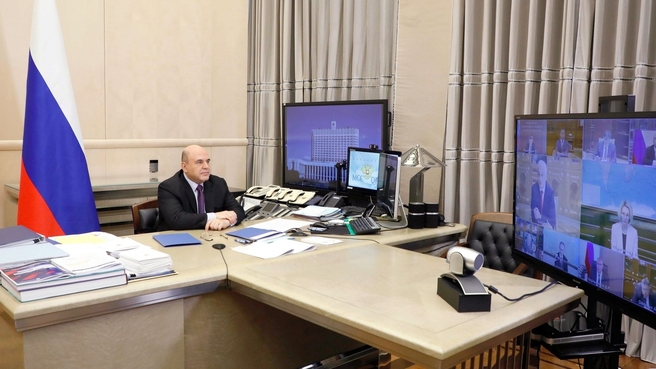The meeting was held via videoconference.
Mikhail Mishustin’s opening remarks:
Good afternoon, colleagues.
Today we will begin with a set of issues on the development of the fuel and energy complex. The Government has approved an action plan for the Energy Strategy until 2035, which was prepared in accordance with the President’s instructions.
The plan includes over 130 measures that concern all sectors of our fuel and energy complex, from mining to the supply of energy and heat to residential buildings.
A separate set of measures has been proposed for each goal. They include increasing LNG production to 140 million tonnes, creating LNG transhipment, storage and marketing centres, opening low carbon hydrogen production sites, developing the electric vehicles charging infrastructure, and launching the production of difficult oil and gas. Most of the planned measures are to be implemented within the next 18 months.
We hope that this strategy will help us attain several goals that are vital for national development as early as in the medium term, specifically, to increase oil and gas condensate production in Eastern Siberia, the Russian Far East and the Arctic, increase LNG production several times over, increase the share of modern domestic or localised foreign technological equipment, and significantly expand the volume of exports to the Asia-Pacific region.
We focus particularly on creating an EAEU common energy market and ensuring Russian business’ competitive participation in it. The plan includes relevant actions in this area.
Now, with regard to developing infrastructure for supplying LNG from Russia to the Asia-Pacific markets, the Government has resolved to allocate over 21 billion roubles for the construction of an access channel to the LNG offshore transhipment complex in Kamchatka with over 5 billion to be allocated this year.
Transhipment in Kamchatka is the key to fulfilling our strategic goal to increase LNG supplies to the Asia-Pacific markets. The new terminal will make it possible to tranship over 20 million tonnes of LNG annually.
The issue is about a promising and growing market with high consumption of energy. We are taking strong action to develop infrastructure in order to expand our supplies to that region and gain a firm foothold there. We look forward to Russia's share in the global market increasing to 20 percent as a result.
That brings us to our next issue. At the President’s initiative, this year was proclaimed Science and Technology Year. We have 10 world-class research and education centres in 20 regions. We have allocated over 1 billion roubles from the 2021 federal budget to support their activities.
These funds will be used to provide each research and education centre with a grant of 128 million roubles which can be used to build infrastructure, purchase the latest equipment for conducting research and implementing projects and also to organise internships for employees and introduce new training programmes.
Already now, these centres are conducting advanced research in the most promising areas, including, among others, smart services, UAVs, the production of fertilisers from industrial waste, AI-based technology, as well as the creation of innovative medical products. I’m confident that Russian researchers can achieve major successes and ensure a leading position for our country in research.
Next, there is the agro-industrial complex that needs our attention. The Government will expand the list of investors entitled to partial reimbursement of expenses incurred in processing agricultural products from the state-operated support funds to include dairy farms that specialise in the production of milk powder which is used in making baby formula and diet food, and in the confectionery industry.
They need to replace their equipment fairly often. The demand for dairy products continues to increase, and the enterprises’ operational load is quite heavy. From now on, they will be entitled to a partial reimbursement of the funds they invested in upgrading their production facilities, namely, 25 percent of the facilities’ actual cost. We hope that this will help enterprises cut the time they need to upgrade their equipment and to acquire the latest technology.








